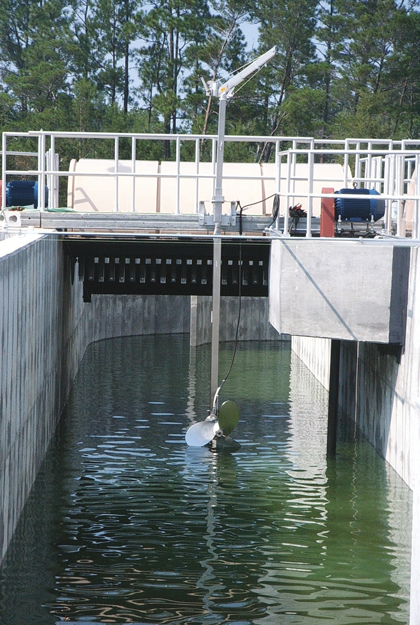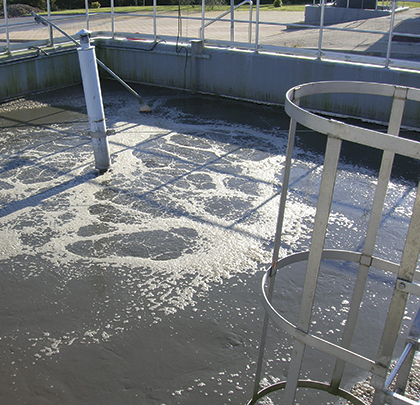If energy-efficient Aeration is not your priority—even when it is well documented that Aeration accounts for a pretty staggering 50 to 70 percent of a treatment plant’s power consumption—then please, turn the page.
Historically, and still to this day—the well-worn “handbook” for determining the SCFM (standard cubic feet per minute) for the use of fine bubble diffused air systems in an activated sludge process says something along the lines of:
- Calculate the air flow required for the oxygen demand.
- Then, calculate the air flow required for mixing.
- Use the greater of those two numbers to size your blower. That’s it!
But, according to two companies with more than 170 years’ experience between them, it may be time to tear up that handbook, or with more and more treatment plants now on a path towards becoming energy neutral, at least bring it into the twenty-first century.
TURNING THE PAGE ON THE OLD HANDBOOK
Traditionally, plug-flow aeration basins for the nitrification of activated sludge were not built with submersible mixers in mind, but continuing to follow “the old handbook” can result all too often in also using equipment such as a blower that is way over-sized for mixing, which wastes large amounts of energy, especially during the night when loads are so much lower.
If that first number in the calculation which asks for the amount of air required for nitrification is greater than the second number for how much air is required for mixing, then fine. But if that second number is greater than the first, then there is an opportunity for power savings. Air flow through diffusers works great for oxygen transfer, but it’s terribly inefficient for mixing. Instead it’s time to bring in a submersible mechanical mixer, which can keep solids in suspension with just a fraction of the horse power that the blower would consume. The use of submersible mixers in a plug-flow aeration basin will further enable the plant to reduce aeration during low-load periods (summer/winter or night time), without losing mixing in the tank.
For many, optimizing the all-important process will naturally outrank energy efficiency concerns; even though up to a staggering 25 percent of a whole city’s total energy use can be consumed by aeration at its treatment plants. However, new grants, EPA funding options and Energy Savings Performance Contracts (ESPCs) should help incentivize the opening to make significant, guaranteed savings, especially as federal agencies can procure energy savings and facility improvements with no up-front capital costs.

ENERGY SAVINGS ALSO IN OXIDATION DITCHES
One company that also uses submersible mixers to actively help its customers reduce their aeration-led energy bills without compromising on their process is Lakeside Equipment Corporation (established 1928), who back in 1964, first introduced the “oxidation ditch process” to the United States.
Vice President Warren Kersten says, “To optimize the process for oxidation ditches and save energy, we use rotor aerators, supplemented by Landia’s submersible mixers. During the aerobic phase we have the mixers switched off, but then later when we switch them on, we turn the rotors off so as not to add oxygen.”
In more recent aeration handbooks, you’ll find all sorts of advice on energy efficiency, largely about controls and speeds, including the use of high-speed Turbo blower systems and air-bearing technology to efficiently produce air flow, but as Warren Kersten continues, the introduction of a mixer—designed for purpose—can play a vital processing and economic role.
“The mixers are put into operation purely for mixing, which unlike other equipment is truly optimized to keep solids in suspension and prevent the tank from going septic. For blowers, variable speed drives may help reduce the amount of power being used, but at the end of the day, a blower is designed to add oxygen, not for mixing. They’re not dual-purpose. We’ve created a cycle so that when the DO (Dissolved Oxygen) drops below 0.5ppm, the bacteria switch from using the free O2 provided by the rotors to attacking the nitrate molecule to obtain their oxygen. We then switch the rotors back on. It enhances the process, and has the added bonus of reducing energy costs.”
A LOOK AHEAD
In next month’s conclusion, we’ll take a look at the energy savings achieved with this Cyclic Aerobic/Anoxic operation using Lakeside Magna Rotors during the aerobic phase and Landia mixers during the anoxic phase, which reduce oxygen requirements by around 27 percent. This saves considerable power costs over the typical twenty-year life of the project. ◆
For More Information: Soren Rasmussen is the director of Landia, Inc. For more information about Landia’s range of applications, call 919.466.0603, email info@landiainc.com, or visit www.landiainc.com. For more information about Lakeside Equipment Corporation, visit www.lakeside-equipment.com or contact sales@lakeside-equipment.com.
____________________________________________
MODERN PUMPING TODAY, December 2016
Did you enjoy this article?
Subscribe to the FREE Digital Edition of Modern Pumping Today Magazine!
![]()


